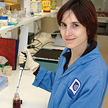Related Questions
- How did people discover that dogs and cats can only see black and white and a few colours?
- Why are plants green? And some times other colours?
- Why are there so many male pilots when most males are colour blind?
- Can you explain the genetics and evolution of skin color? Is skin color useful for grouping people into ethnic groups?
- does the colour of your iris affect your eyesight









Hi treant,
A supernova is the explosion of a dying star. It makes a BIG MESS. All the different kinds of stuff that are thrown into space give off light of different colours: not only in the colours of the rainbow, but in the colours that are outside the rainbow and that people can’t see with their eyes. (The colours that are bluer than blue are called UV, X-rays, and gamma-rays; the colours that are redder than red are called infrared and radio.)
So supernovae are naturally colourful. And pictures of them — and of lots of other things like galaxies and big clouds of gas — are even more colourful in pictures than they would be if you looked at them with your eyes, because astronomers “look” at them using equipment that can “see” the colours outside the rainbow, and then show those colours as normal colours. So the colours you see on the picture are “not really” the colours coming from the object.
An example. The galaxy Centaurus A looks like this in normal light:
http://chandra.harvard.edu/photo/2002/0157/0157_optical.jpg
In radio (redder than red light) it looks like this:
http://chandra.harvard.edu/photo/2002/0157/0157_radio_continuum.jpg
In X-ray (bluer than blue light) it looks like this:
http://chandra.harvard.edu/photo/2002/0157/0157_xray.jpg
And if you put all three together, you can make a nice colourful picture:
http://chandra.harvard.edu/photo/2002/0157/0157_xray_opt_radio.jpg
Neat, eh?
0
Hi treant,
Supernovas make some of the most beautiful pictures! I always thought they start out bright white – because they are so hot as the star explodes. Then, as the matter and gasses that explode cool, they emit different wavelengths, hence making them appear a different colour.
That’s pretty interesting what Edward saya about the telescopes being able to “see” more of these colours than our eyes can – so they would not be so beautiful if we could see them with the naked eye. 🙁
0